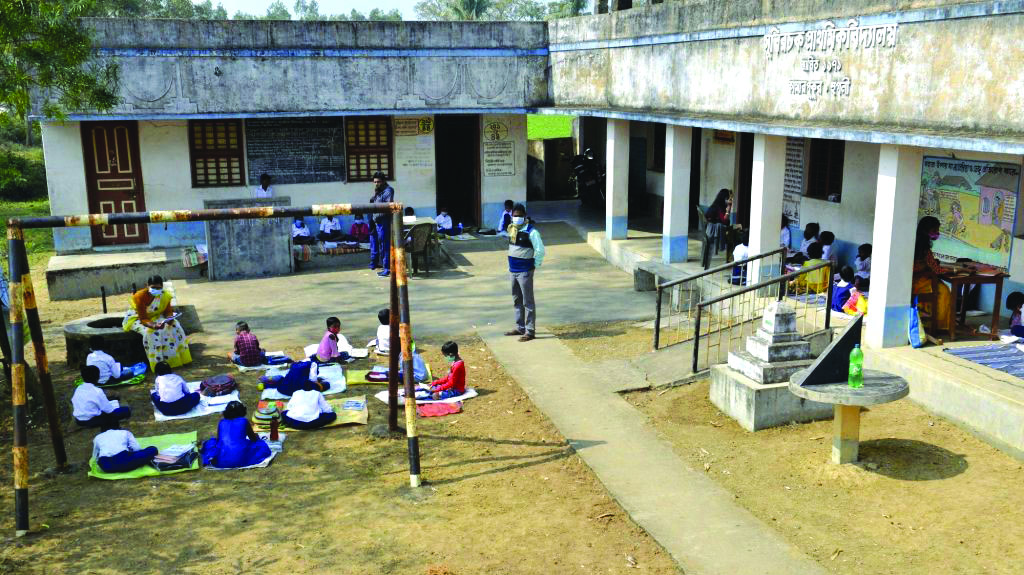Baishali Mukherjee (Kolkata)

Bengal rural government primary school
With dates of general Election 2024 declared, the political mercury in West Bengal (pop.91 million), set for seven-phase polling from April 19 to June 1, has touched unprecedented levels. Leaders of the ruling Trinamool Congress (TMC) and resurgent BJP are trading vitriolic diatribes, indulging in character assassination and slanderous allegations to discredit their opponents and sway public opinion.
Meanwhile as political parties are engaged in relentless slugfests, West Bengal’s education system is experiencing a huge crisis. There’s an acute shortage of teachers in the state’s 92,000 public/government schools as recruitment has been stalled for the past seven years because of multiple complications and pending court cases.
Recruitment following the Teacher Eligibility Test (TET) 2015 has been stalled because of several petitions filed in various courts alleging irregularities in the selection process. Simultaneously, the state’s primary education board hasn’t appointed 150,000 candidates selected from TET 2022 as a Calcutta high court order has barred new recruitment before appointment of all successful TET 2015 candidates. This situation has been further complicated by a fresh case filed in the Calcutta high court by 500 aspirant teachers in September 2023, alleging that there were 15 “wrong questions” in TET 2022.
Hearings in the latest case were held on March 12 and 20, in which Justice Rajashekhar Mantha stressed the need to find a “permanent solution” to fix recurring problems with TET exam questions. Moreover, responding to WBBPE (West Bengal Board of Primary Education) chairman Goutam Paul’s statement that all questions were framed after consulting specialists, Justice Mantha asked for an affidavit from the said specialists.
It’s pertinent to note that a verdict ruling that the questions were inappropriate will further complicate the recruitment process leading to all candidates who attempted the flawed questions in TET 2022 receiving full marks by default. This outcome will significantly alter the landscape, increasing the number of individuals qualifying in TETs.
With recruitment stalled for seven years, the number of teacher vacancies statewide is estimated at 3.5 lakh. In rural Bengal in particular there is a severe shortage of teachers with the teacher-pupil ratio having risen to 1:59 against the 1:35 prescribed by the Right of Children to Free & Compulsory Education (RTE) Act, 2009. Moreover, 6,845 primary and 1,362 upper primary schools in the backward districts of Purulia, Bankura, Birbhum, Jhargram, Murshidabad and West Midnapore were shut down in March 2023, after an education ministry report revealed that they have less than 30 students on their muster rolls.
This closure of schools highlights that a large number of children are dropping out of school, especially from higher secondaries with boys’ drop-out rate being higher. In 2021, while 10.5 lakh students cleared the class X board exam only 8.5 lakh wrote the higher secondary (plus II) exam in 2023.
With increasing drop-out rates after class X the gross enrolment ratio in undergrad college education has also dropped sharply. In 2017-18, West Bengal’s GER (gross enrolment ratio) in higher education was only 18.7 percent, cf. the national average of 25.8 percent. Women’s GER was even lower, at 17.6 percent. Moreover, with nine colleges per 100,000 population, West Bengal is way below the all-India average of 25 colleges per lakh population.
Comments Prof. Pabitra Sarkar, a renowned academic, former vice chancellor of Rabindra Bharati University and former vice chairman of the West Bengal State Council of Higher Education: “The dismal state of education in West Bengal has far-reaching implications. The lack of access to quality education perpetuates cycles of poverty, unemployment, and social marginalisation, exacerbating socio-economic disparities and hindering inclusive growth. Without adequate investment in education, West Bengal risks being left behind in an increasingly competitive and interconnected world, perpetuating a cycle of underdevelopment and stagnation.”
For this alarming situation in primary-secondary and higher education, a rising number of academics are faulting the lackadaisical attitude, bordering on indifference of the ruling Trinamool Congress government — now in its third consecutive five-year term in office. The consensus of academic opinion is that by eroding educational standards and neglecting human capital development, Banerjee is undermining the state’s long-term prospects for sustainable development and prosperity.
\With her seeming lack of urgency about teacher recruitment and apathy about the future of children and youth in the state, the chief minister is fast losing the support of not only Kolkata’s influential bhadralok (cultured middle class) but the grassroot electorate as well. Monitors of West Bengal’s political scene feel that though the electoral landscape of Bengal is complex and the outcome of General Election 2024 will be influenced by a combination of factors — West Bengal sends 42 representatives to the Lok Sabha in Delhi — a decline in support for Banerjee due to her failure in the education sector has given the resurgent BJP (which won 18 constituencies in General Election 2019), an opportunity to capitalise on the discontent of voters.
Also read: West Bengal: Teachers oppose UGC rules for college grants eligibility























